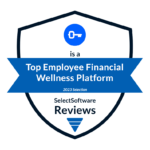Realizing that financial wellness solutions such as financial education, coaching, and planning are not moving the needle on employee financial health, some employers are now considering different approaches. As a result, workplace emergency savings accounts (ESAs) are a type of employee benefit that has increased in popularity. While having liquid savings is an important component of financial health, workplace ESAs simply aren’t enough to support the 70% of Americans who are not financially healthy.
Here are six reasons workplace ESAs fall short as an employee financial health benefit and what employers should consider instead.
1. Employees don’t believe they can save
Proponents of emergency saving accounts often tout stats such as “more than one in four Americans has savings of less than $1,000” as a reason workplace ESAs are the key to solving employees’ financial problems. While it’s true that a workplace ESA can empower employees to avoid financial institution fees and remove barriers for the unbanked/underbanked, they don’t address one major problem: Employees living paycheck to paycheck don’t believe they can save. In fact, just 10% of Brightside users tell us they have money left to save from each paycheck when they first start working with us.
Yet, once they receive personalized support from their Brightside Financial Assistant, including help with debt management and finding money, they uncover opportunities they didn’t know they had. That’s how 50% of Brightside users begin autosaving from each paycheck – despite that many have never saved before. Without that personalized support, they would continue to believe saving is impossible.
2. Root causes of financial illness aren’t addressed
Workplace ESAs only treat the symptoms of poor financial health, rather than the causes of financial illness. Many frontline employees are dealing with bills that outweigh their cash flow, debt, low credit scores, and struggle to afford basic needs, including housing and transportation. They need help breaking free of these challenges, which may require temporary support from local resources and government programs, so they can establish the financial stability to build savings and take other steps to improve their financial health.
3. Employee financial health isn’t limited to savings
Financial Health Network measures financial health based on these eight indicators:

Source: Financial Health Network
A workplace ESA doesn’t give employees the tools or support they need to address these other important financial habits.
4. Human-led, personalized support is necessary
Employees need support from a non-judgmental, empathetic partner who will help them navigate to the best possible option for their unique situation, so they don’t drain their emergency savings account needlessly. This navigation should include connecting employees with free government and community resources whenever possible, as well as other relevant employer benefits, such as an EAP or legal aid. The more dire an employee’s financial situation, the more likely it is to be surrounded by complex circumstances which can range from domestic violence to mental health challenges.
5. Lack of organizational impact
Workplace ESAs might help reduce employees’ short-term financial stress and when employer-funded, can be a recruitment tool. But they won’t deliver the lower healthcare costs, reduced turnover, or increased productivity that employers (and ultimately, shareholders) want to see.
Employers must provide comprehensive financial health benefits that are uniquely designed to treat financially illness and improve employees’ financial health, in order to see ROI from their investment.
Why offering Brightside Financial Care is a better choice than workplace emergency savings accounts
Workplace ESAs are limited in scope and don’t address the broader financial challenges employees face. Brightside Financial Care is a comprehensive financial health platform grounded in behavioral science, that provides employees with personalized support from empathetic Financial Assistants and real solutions that support their financial health. These include a free Brightside Savings Account, where employees earn a competitive interest rate and can get rewarded for autosaving from each paycheck, and a free Brightside Spending Account, which provides early access to their paycheck with direct deposit and includes a Cash Advance feature (up to $100) for emergencies.
Employees can access these and other financial resources in in the easy-to-use Brightside app, so it’s easy to build savings, track spending, and get personalized support from their Brightside Financial Assistant as many times as they need, at no cost to them. The impact Financial Care has on employees and their employers is evident in results such as:
- 50% of employees who engage with Brightside begin saving automatically from each paycheck
- Brightside puts $1,200 on average back into employees’ pockets
- Employers such as Amazon and other Fortune 500 customers see measurable ROI including reduced turnover, employees working 36+ more hours each year, and fewer 401(k) hardship withdrawals
To learn more about Brightside Financial Care, click here.





